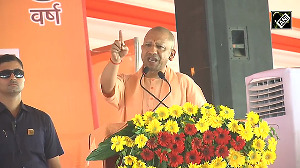Religious tourism witnessed 1,439 million tourists in 2022, generating Rs 1.34 trillion in revenue.

IMAGE: A Naga sadhu waves the Indian flag as he takes a dip in the Ganga in Haridwar. Photograph: Anushree Fadnavis/Reuters
The droves of pilgrims congregating at the Maha Kumbh in Prayagraj gave a glimpse of how faith can play a major part in pushing religious tourism, leading to employment and revenue generation.
According to recent ministry of tourism data, religious tourism witnessed 1,439 million tourists in 2022, generating Rs 1.34 trillion in revenue.
Religious tourism is expected to generate $59 billion by 2028 and create 140 million temporary and permanent jobs by 2030, according to a report on spiritual tourism by PHDCCI.
More than 60 per cent of tourism in India is associated with religion, according to the report released on the occasion of a spiritual tourism conclave organised in Ayodhya last year.
According to information received from Uttar Pradesh, there is substantial increase in religious tourism in Ayodhya after construction of the Ram temple.
The total number of visitors to the district has risen from 6.02 million in 2020 to 164 million in 2024, said the Union tourism ministry, quoting figures received from the state government.
The Maha Kumbh gave further impetus to religious tourism. UP Chief Minister Yogi Adityanath pegged revenue generation from the religious congregation at Rs 3 trillion to Rs 3.5 trillion.
The tourism ministry initiated the National Mission on Pilgrimage Rejuvenation and Spiritual Heritage Augmentation Drive in 2017 to promote the sector as a major growth engine.
As much as Rs 1,646.99 crore (Rs 16.46 billion) has been sanctioned to upgrade 48 projects in 27 states and Union Territories, of which Rs 1036.96 crore (Rs 10.36 billion) has been released, with 25 projects completed, 22 under construction and one dropped.
Overall, India's tourism industry is seeing an extraordinary resurgence, driving economic growth, and foreign exchange earnings.
According to the latest India Tourism Data Compendium 2024, the sector has bounced back from the pandemic, surpassing pre-2019 levels in several key indicators.
Many states are focusing on tourism to give a boost to the economy.
This holds particular importance in states that rely on tourism much more than others.
However, despite this, tourism's share in total employment has declined from FY19 to FY23, reflecting shifts in workforce dyna mics and the growing influ ence of other economic sectors.

India recorded 9.52 million foreign tourist arrivals in 2023, marking a 47.9 per cent increase from 2022.
Additionally, non-resident Indians hit a record 9.38 million arrivals, further boosting international tourism numbers.
The top five countries contributing to foreign arrivals were Bangladesh, the United States, the United Kingdom, Australia, and Canada.
Domestic tourism also experienced a remarkable boom, with 2.5 billion domestic tourist visits in 2023, reflecting a 45 per cent increase from 2022.
Foreign exchange earnings (FEE) from tourism saw an impressive rise, amounting to $28.077 billion in 2023, compared to $21.360 billion in 2022, registering a 31.5 per cent growth.
Among domestic travelers, Uttar Pradesh and Tamil Nadu emerged as the most visited states, with 478.53 million and 286.01 million visits, respectively.
Meanwhile, Maharashtra and Gujarat attracted the highest number of foreign visitors, recording 3.39 million and 2.81 million arrivals, respectively.
For heritage tourism, the Taj Mahal remained the most visited monument, drawing 6.10 million domestic and 0.68 million foreign tourists in the last financial year.
Other popular heritage sites included the Qutub Minar in New Delhi, the Agra Fort in Agra, and the Sun Temple in Konark.
Feature Presentation: Ashish Narsale/Rediff.com












 © 2025
© 2025